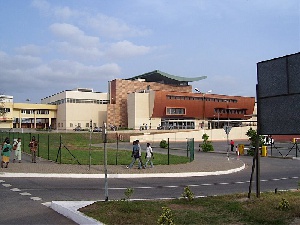...As it witnesses travel boom
...Head porters carry luggage from tarmac to arrival hall
Official statistics show that the number of international passengers who travelled through the Kotoka International Airport between January and August 2011 was one million, 16.7% more than the 900,000 passengers recorded over the same period in 2010.
For domestic flights, 106,000 passengers have been recorded over the same period in 2011, representing a 29.6% rise over the 81,000 passengers recorded in 2010. Besides, more airlines are showing interest in the Ghana route. Within the last two years, five or more new airlines have listed on the Ghana route. These are: Air Namibia, United Airlines, Virgin Atlantic, Tap Portugal. Royal Jordanian Airlines is expected to commence operations in the next few days or weeks. The domestic market has also seen the entry of Aero Survey (Starbow) and Fly540. All these have meant increased revenue generation, increased competition resulting in lower airfares, more employment and more options for travelers. It has also meant increased pressures on existing infrastructure, most of which have not seen any rehabilitation in more than two decades. The baggage conveyor belt is said to break down as often as three days in a week and sometimes can be out of use for weeks, compelling ground staff to carry checked luggage from the departure lounges into trolleys on the tarmac. This partly explains the frequent reported damages to passengers' bags.
The Acting editor of Public Agenda recounts an occasion when passengers' luggage had to be carried by head porters from the tarmac to the arrival hall because all the conveyors were out of order as he returned from an official trip abroad. The airport's inability to cope with the increasing air traffic is evident in the congestions that have now become a routine feature of the departure terminal. The situation has compelled authorities to move departure formalities for some flights to the domestic terminal. And there is also the many domestic flight cancellations and the accompanying disappointment.
Inspite of these obvious challenges, the Ghana Civil Aviation Authority (GCAA), the body that provides regulatory oversight, facilities and services for air transportation in the country, says this year has been a major success.
New equipment
"The first thing I would like to talk about is the acquisition of technology to meet the ever changing safety needs in the aviation industry," Air Cdre Kwame Mamphey, Director-General, GCAA, stated on the occasion of the 67th International Civil Aviation Organisation Day celebration, which the GCAA used to showcase and commission new communication, navigational and surveillance installations.
At a cost of one million dollars, the GCAA has installed a new Doppler Very High Frequency Omni-Range (DVOR) Distance Measuring Equipment (DME), an equipment used for air navigation services within the vicinity of the airport, precisely at a spot close to the underpass that links East Legon to the Spintex Road. This equipment, according to GCAA officials, enables pilots to navigate aircraft safely and efficiently to or from airports under all weather conditions.
With this equipment, pilots do not need sole dependence on Air Traffic Controllers (ATC). According to officials of the GCAA, the new DVOR/DME replaces the old equipment "due to the massive encroachment of land around the DVOR site which disturbed the transmissions from the equipment. The height of the new DVOR's antenna has therefore been raised to about 8metres above the ground as compared to the earlier one which was about 3metres.
Almost $800,000 has been spent on an Automatic Dependence Surveillance-Contract/Controller Pilot Data Link Communications (ADS-C/APDLC), a technology that enables air traffic controllers communicate with pilots over a datalink system.
"I am also glad to announce the installation of a new High Frequency Radio (HF) and a selective calling system. Additionally, in collaboration with GMET [Ghana Meteorological Services Agency], an Automatic Weather Observation System has been installed in Accra for the provision of a more efficient and accurate weather information," he told journalists on 7th December, 2011.
Isaiah Tefuttor, Electronics Engineer, explains that the new technology allows for communication between the Ghana Airport and aircrafts along the entire Ghana airspace which covers the whole of Ghana, Togo and Benin as well as the oceanic airspace, stretching as far as the Angolan waters.
According to Ben Sowah-Ashong, an Air Traffic Controller, the ADS-C/APDLC has been under trial for the past three months and is likely to be in full use at the start of the new year.
Commissioning the new DVOR/DME, Alhaji Collins Dauda, Minister for Transport, said "With the development of the aviation industry in Ghana since 1918 when the idea of aerial transportation in the Gold Coast was conceived by the then British Colonial administration, it seems to me that this year has seen a lot of significant developments in Ghana Civil Aviation's history, especially relating to technological advances and achievements."
A week later at the Meet-The-Press series, the Minister said the advancements were a "reflection of the stable political, social and economic atmosphere and prudent policies of Government, especially the implementation of the Liberalized skies policy.
The GCAA has not been forthcoming with information on plans to rehabilitate the crumbling facilities at the airport as well as expansion to cope with the increasing numbers of passengers who use the facilities. Attempts to get the Public Affairs Department or management to provide responses to specific questions related to Public Agenda's investigations was met with several excuses and procrastinations.
Author: Frederick Asiamah













